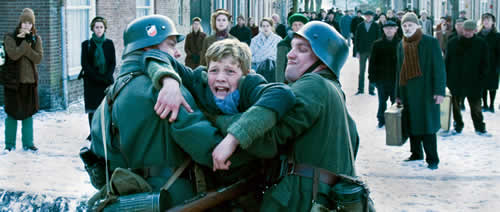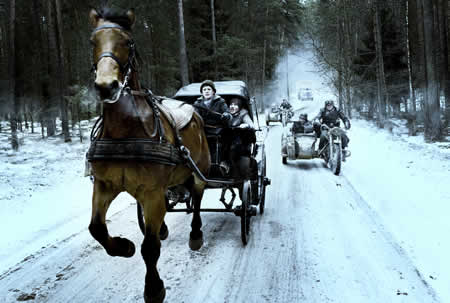 Winter in Wartime happens in Nazi-occupied Holland, 1945. In a snow-covered village, thirteen-year-old MICHIEL (Martijn Lakemeier) is drawn into the Resistance when he aids a wounded British paratrooper. Michiel‘s boyish sense of defiance and adventure soon turns to danger and desperation, as Michiel is forced to act without knowing whom to trust among the adults and townspeople around him. Wartime‘s harsh reality encroaches on childhood innocence as Michiel confronts good and evil, courage and duplicity, and his own burden of responsibility.
Winter in Wartime happens in Nazi-occupied Holland, 1945. In a snow-covered village, thirteen-year-old MICHIEL (Martijn Lakemeier) is drawn into the Resistance when he aids a wounded British paratrooper. Michiel‘s boyish sense of defiance and adventure soon turns to danger and desperation, as Michiel is forced to act without knowing whom to trust among the adults and townspeople around him. Wartime‘s harsh reality encroaches on childhood innocence as Michiel confronts good and evil, courage and duplicity, and his own burden of responsibility.
Cinema Without Borders interviewed Martin Koolhoven director of Winter in Wartime last week.
Bijan Tehrani: My first question is when and how did you encounter Jan Terlouw’s book and what motivated you to make Winter in Wartime adapted from the book?
Martin Koolhoven: I was on vacation in Norway and I had taken a pile of books with me. I was looking for a story that was set in a war and Winter in Wartime was quite a famous book and I never really understood why it had never been made into a movie before. I read the book in one night and just loved it and I felt that it was something that I really wanted to do. I fell in love with the main character and I had a good idea of where I felt that the movie should be going, so I called the producer in the morning and I said that he had to get the rights to the book. I was afraid that the rights were already taken since the Book is from 1973; luckily they were still available, so we started writing the screenplay.
 BT: Is the book is based on a true story?
BT: Is the book is based on a true story?
MK: I spoke to the author Jan Terlouw, who is a famous politician. He told me that a lot of the things in the book are autobiographical and that most of the things in the book are his experiences or experiences that he had heard of.
BT: How challenging was it to make Winter in Wartime?
MK: Well it was the toughest film that I ever directed, and we had a lot of set-backs. For one, I really wanted to create Holland 1945 in the snow, because winter that year was a famously tough winter. But we don’t always have that kind of winter weather here, so I went to look for a place that is visually the same as Holland but where it also snowed heavily. We went to Lithuania, which is close to Russian and looks a lot like Holland. Of course, when we went there it was the warmest winter in 120 years, so there was no snow and everything was flooded, therefoer we had to use shoot other scenes first and then wait for the snow and augment it with fake snow.
 BT: How did you go about casting the film?
BT: How did you go about casting the film?
MK: I do get a lot of compliments on the acting in my films, and I believe that half of my job is done when we just cast the right people. For Winter in WartimeIt was important to find the right actor for the young boy in the film, Michiel. We had a lot of 14 year old boys showing up for the tests and it took us a long time to come across Martijn Lakemeier, but when we did find him, we were certain that he was right for that part and that was a big step towards making the film. Winter in wartime is really about that young chracter, Michiel, and whole film is told through his eyes. I think Martijn Lakemeier was really a fantastic choice.
BT: How did you direct this Martijn Lakemeier for the Michiel part?
MK: Most of the time I directed him as I would direct any other actor, he was a really smart kid and he had the power to be put in any situation. The thing which I sort of exploited was that he was at a point in his life which paralleled that of the character in the film, where he has one leg in adolescence and one leg in maturity. When we shot the end of the movie, he actually had grown with us and experienced everything his character does in the movie. We shot his parts chronologically and according to the progress of the story, and when we shot the ending of the film, he was not the same boy anymore. When you are a young child and you are in Lithuania with a rough and tough people around you that resemble cowboys, and a film crew, it’s a life-changing experience.
BT: How did you work with the screenwriters?
MK: First there were two: first I was writing it with Paul Jan Nelissen and we were working on it for quite a long time. Sometimes we would meet and then go off and write again, but there was just something missing in the screenplay and something that we could not get right. We then asked a screenwriter that I had worked with several times before, Mieke De Jong, for help. She is very good with character and she basically blew more life into the characters.
BT: How did you come up with the visual style of Winter in Wartime?
MK: The first image that I saw in my mind was the boy in the snow and everything evolved from that. But later I realized that basically the movie is about the loss of innocence and if you create a virgin environment for the movie it really works well. In Holland there are already a lot of war movies that were made; by giving the film a different look, it made the film look a bit fresher. I am big fan of Italian Spaghetti Westerns and that had a big influence in the film’s style, a style that is both stylistic and realistic. A good part of the film is told through point of view of characters and there are many moments that are operatic and bombastic and emotional, and that is something that I have learned from Spaghetti Westerns.
BT: Do you have any new projects lined up?
MK: I’m working on several projects, but the one that I’m focusing on is actually a thriller set in the old west.
BT: Thanks for all of your valuable insight!
Winter In Wartimes opens in NY & LA on March 18th.

